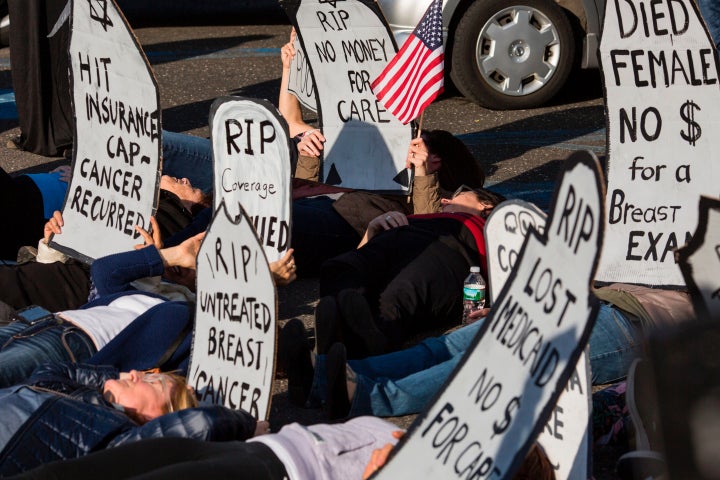
The new Congressional Budget Office numbers are in for the House healthcare bill, and they’re almost as breathtakingly bad as the first version’s score. Instead of 24 million Americans losing health insurance in the next ten years, now “only” 23 million will lose health insurance. The number of people who will lose health insurance next year alone stayed the same, at 14 million. Medicaid funding will be cut by $834 billion, instead of $880 billion. This would save a paltry $12 billion a year, instead of the $15 billion a year the original bill would have saved. That’s a lot of pain for not very much money saved. Which Democrats are going to be pointing out soon, in midterm ads.
This legislation had two major goals. The first was to provide a whopping tax cut for wealthy people. The second was for Republicans to be able to claim “we repealed Obamacare.” Measured on those metrics, the bill is a success. Measured by any other metric, it is a complete disaster.
The top-line numbers do not tell this story adequately. A $12 billion change in the federal budget is peanuts, after all. But when you dig into the numbers, the intent of the legislation becomes more obvious. Here are a few crucial paragraphs from the C.B.O. report (emphasis added):
CBO and JCT estimate that, over the 2017-2026 period, enacting H.R. 1628 would reduce direct spending by $1,111 billion and reduce revenues by $992 billion, for a net reduction of $119 billion in the deficit over that period. The provisions dealing with health insurance coverage would reduce the deficit, on net, by $783 billion; the noncoverage provisions would increase the deficit by $664 billion, mostly by reducing revenues. The largest savings would come from reductions in outlays for Medicaid and from the replacement of the Affordable Care Act’s (ACA’s) subsidies for nongroup health insurance with new tax credits for nongroup health insurance (see figure below). Those savings would be partially offset by other changes in coverage provisions ― spending for a new Patient and State Stability Fund, designed to reduce premiums, and a reduction in revenues from repealing penalties on employers who do not offer insurance and on people who do not purchase insurance. The largest increases in the deficit would come from repealing or modifying tax provisions in the ACA that are not directly related to health insurance coverage ― such as repealing a surtax on net investment income, repealing annual fees imposed on health insurers, and reducing the income threshold for determining the tax deduction for medical expenses.
Below this is a chart, breaking down the impact of various parts of the bill. Medicaid is slashed a jaw-dropping $834 billion, and tax credits for people to buy insurance gets hit by $276 billion. Where does all this money go? Mostly to “noncoverage provisions,” to the tune of $664 billion. What are “noncoverage provisions”? Here’s the explanation (emphasis added):
Repeal or delay of taxes on high-income people, fees imposed on manufacturers, and excise taxes enacted under the ACA. Modification of various tax preferences for medical care.
Got that? We’ve got to slash Medicaid to give a huge tax break to “high-income people.” And 23 million of our fellow Americans can crawl off into the woods and die, because this entire exercise was nothing more than a way to cut taxes on the ultra-wealthy. As I said, Democrats should already be drafting their campaign ads around this basic fact.
By magnanimously allowing an extra million people to keep their health insurance, the Republicans did fix one glaring problem with their first attempt. Now the number of uninsured will be exactly what it would have been if Obamacare had never happened. Incredibly, the first draft of this bill somehow denied health insurance to a million more people than a flat Obamacare repeal would have done. So at least now Republicans can’t be accused of making things even worse than they would have been if Obama had failed to pass his law.
Still, “things won’t be worse than the status quo before Obamacare” isn’t really a rousing campaign slogan for the GOP. Democrats will be pointing out that this bill is in no way real deficit reduction, since after slashing Medicaid by $834 billion it only saves the government $119 billion in the end ― because of the $664 billion tax windfall.
Republican senators have all but announced they’re tossing the House bill out and starting with a blank sheet of paper. They may come up with their own bill, or they may be incapable of reaching agreement among themselves (if only three Republican senators decide not to vote for a bill, it will die ― a pretty thin margin). If the Senate acts and produces a slightly-less-breathtakingly-bad bill, then the focus may shift before the election cycle really gets underway. But whether the Senate acts or not, the House votes are already on the record. They voted for this Draconian bill, and their Democratic opponents should take every opportunity to point it out to their constituents.
The House Republicans congratulated themselves for throwing 23 million people off their health insurance. They slashed Medicaid by over $800 billion. They handed most of this money out to the wealthiest Americans, for no reason whatsoever. By doing so, they are saving a grand total of $12 billion a year in a $4 trillion budget ― a deficit reduction of roughly one-third of one percent. The numbers are in, and they’re bad. Spectacularly bad. Breathtakingly bad. Whatever else happens, House GOP members won’t be able to run away from them.
Chris Weigant blogs at:
Follow Chris on Twitter: @ChrisWeigant
